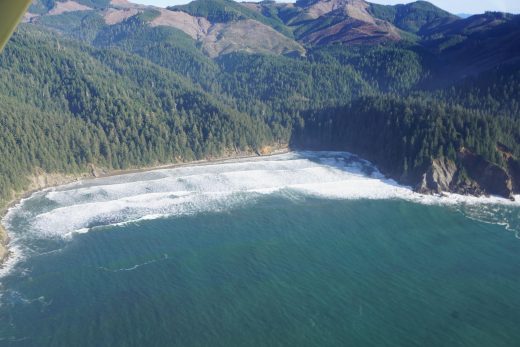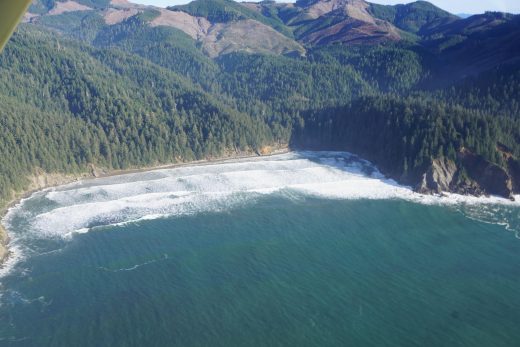
Guest blog by Arica Sears with the Rockaway Beach Citizens for Watershed Protection (RBCWP), a citizens group that was founded in 2012 in response to the clearcutting and aerial spraying of the Jetty Creek watershed that provides drinking water for the City of Rockaway Beach, Oregon.
Where does paradise begin and industry end?
Nestled off Highway 101 between Manzanita and Arch Cape is a short, white, sandy beach that can be reached by earthy trails winding through Oswald West State Park. Surfers love Short Sands Beach for the beautiful waves that roll up its shore, families bring their children to play in Short Sand Creek before it flows into the ocean, dogs chase each other while their owners comically chase after them, and visitors are blown away by the stunning view. But while all of these beach-goers are looking out at the Pacific Ocean admiring the Cape Falcon Marine Reserve, chemicals are quietly infiltrating the streams, the watersheds, and eventually run off onto Short Sands Beach, one of the most popular beaches in Oregon.
 Shorties from the air. Photo by Bri Goodwin, Surfrider Foundation. Flight provided by LightHawk.
Shorties from the air. Photo by Bri Goodwin, Surfrider Foundation. Flight provided by LightHawk.
Why should I care?
Spraying chemicals on recently harvested timberlands is a normal activity in Oregon but when compared to Washington, Idaho, and California it’s clear that the lack of regulations, buffers and protections are anything but normal. These neighboring states have larger buffer zones around schools, homes, and streams whereas in Oregon there is only a 60 foot buffer around fish-bearing streams. Timber and chemical companies often claim that chemicals in isolation are safe to human health but these companies usually spray using a cocktail of different chemicals. The effects of combined chemicals have little to no testing and their impacts on human health are not known. Citizens that have unfortunately come into contact with chemicals by way of drift have reported skin rashes, nosebleeds, vomiting and a large list of other symptoms. Timber companies don’t have to release what chemical cocktail they use so when a citizen has been sprayed or their water has been contaminated, they are unable to identify the chemicals and therefore the best method of medical treatment.
Umm, hello? Who is doing this?
The private timber owner, Weyerhaeuser, clearcut the land adjacent to Oswald West State Park back in 2016, and then, as allowed by the Oregon Forest Practices Act, sprayed chemicals from helicopters to kill off all competing plants that would slow the growth of the next batch of harvestable trees. These chemicals included clopyralid, sulfometuron methyl, and Esplanade F. An active ingredient in Esplanade F is Indaziflam. The Environmental Protection Agency (EPA) labeling for Indaziflam specifically prohibits aerial spraying of this chemical due to its extreme toxicity to fish, invertebrates, and aquatic plants, an increased risk of drift, and the high likelihood of transport in ground and surface water. In addition to the environmental concerns, there is also the risk to human health. Repeated exposure can cause organ damage and toxicity to humans. In subchronic studies Esplanade F was shown to cause neurobehavioral effects and neuropathological changes in dogs and rats. Given over a million visitors come to this park annually, the risk is extremely high at this beloved state park.
Timber companies are required to notify the Oregon Department of Forestry (ODF) of planned operations, but they aren’t required to alert the public. Weyerhaeuser sprayed again on May 22nd of this year and will most likely spray again in the fall and for years to come. But will the public be notified? Only if one is able to use FERNs, ODF’s clunky online monitoring system that gives a whopping six-month window in which spraying may be done at anytime. In other words, the public won’t know exactly when during those six months the spraying will happen and therefore, can’t plan to evacuate the area during spray operations. And the news gets worse…….. Weyerhaeuser is only one timber company and Short Sands is only one critical area being negatively affected by private timber interests. This situation is happening all over our beautiful green-patched state.
Are we doing something about this?
Unfortunately, many people aren’t aware of Oregon’s outdated forestry practices. There is, however, a local citizens group working to keep coastal watersheds healthy. The Rockaway Beach Citizens for Watershed Protection (RBCWP) is comprised of concerned citizens of Tillamook County who are demanding better standards for air and water quality. By holding public education events, attending Board of Forestry meetings, closely monitoring timber activities, and asking tough questions of policymakers, this volunteer-based group refuses to give up a sustainable future for the next generation.
RBCWP also partners with unwavering groups such as Beyond Toxics to continue fighting for a cleaner and healthier Oregon. Beyond Toxics has been a loud voice at the state level pushing legislation that would end aerial spraying of pesticides. They have also worked at the local level to educate the public about current timber activities and give a voice to citizens who have been sprayed. They were quick to help RBCWP write a letter of concern to ODF, Department of Environmental Quality and Oregon Department of Agriculture regarding the Short Sands Spray and negative impacts it will have on our communities, visitors and environment.
Oregon Wild has also been a strong ally of RBCWP and fellow groups working on the anti-aerial spray campaign. They organize watershed-focused conferences, workshops on how to use FERNs, and provide capacity for grassroots organizing. Oregon Wild has joined RBCWP at Short Sands to provide technical information about spraying and timber activities to beach goers. They have also created petitions to stop dangerous timber activity and focus on environmental and public health.
Questions worth asking
Why should we as citizens have to monitor private businesses’ activities when this should more rightly be done by State and Federal agencies? Why are for-profit private corporations allowed to conduct operations that negatively affect our water and air quality? A member of the RBCWP group decided to dig a little deeper and what he found was alarming. The area above Necarney Creek was clearcut, sprayed with chemicals to kill numerous plants, burned over, and sprayed again to kill additional plants, all within a short period. Meanwhile, a bridge which had allowed the free flow of Necarney Creek down into Short Sands was replaced with a corrugated pipe culvert surrounded by gravel. A culvert of this type would prohibit fish passage and healthy water flow. How are these practices allowed?
When Weyerhaeuser submitted their plans to ODF to spray the area, public comment was allowed and a member of the public made the following comment regarding their plan that was then included on the FERNs website:
“if Weyerhaeuser proceeds with this plan, ODF and Weyerhaeuser should make plans to notify the managers of the park prior to the application and ODF, the park and the timber company should take on the responsibility of ensuring that the public knows when this operation will take place, so that pregnant women and young children will not be harmed by the effects of drifting chemicals that are known to be dangerous to them.”
Where were the public notices for this spraying? Apparently, just as invisible as the chemical drift that certainly happened shortly afterwards.
What should we do now to “Save Shortys!”?
RBCWP believes the first step is improving Oregon’s weak forestry regulations by educating people in our communities as to what is happening. Where does your water come from? Who owns your watershed? What kind of activities are taking place around your water that can be harmful to you and your family? Answering these questions is pivotal in protecting community health, fish and wildlife, safe recreation opportunities, and our environment.
Once you find answers to these questions and realize there is a big gap between how our watersheds are currently being treated and how they should be protected and sustained, speak up! It’s time we Save Short Sands and save the rest of our coastal watersheds. Connect with a local group like RBCWP, contact your policymakers, write informed letters to the editor, and express your concerns to the timber companies. Although aerial spraying of pesticides has been a big part of Oregon’s history for a long time, it shouldn’t be a part of our future.
RBCWP believes that Oregonians have the right to drink clean water and breathe clean air. Who can argue with that?
